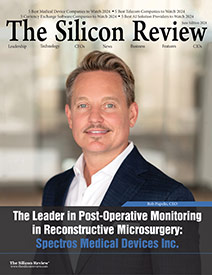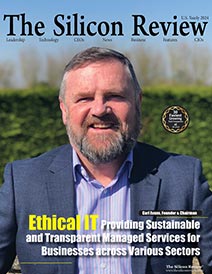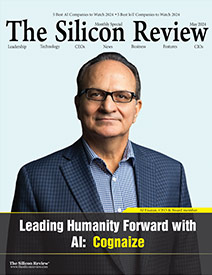30 Most Attractive Companies of the Year 2018
An Interview with Richard Jenkins, Saildrone, Inc. Co-founder and CEO: ‘We Believe in Using Ocean Data at Scale to Derive Quantified, Planetary Insights that Affect Humanity’
The Silicon Review
![]()
“We are building the world’s largest high-resolution ocean datasets, working with governments and private companies around the globe.”
The volume, diversity and frequency of ocean data is increasing as the cost of sensors fall, new low-cost satellites are launched, and an emerging drone sector begins to offer new insights into our oceans. In addition, new processing capabilities are enhancing the value we receive from such data on the biological, physical and chemical properties of our oceans.
In view of the above-mentioned scenario, we’re thrilled to present Saildrone, Inc.
Saildrone collects and delivers live ocean data through a fleet of autonomous sailing drones. It offers ocean data for a range of applications, such as long-range weather forecasting/oceanography and climate, fish stock analysis, and environmental monitoring or preventing catastrophic ecological disasters.
The company was founded in 2012 and is headquartered in Alameda, California.
Richard Jenkins, Saildrone, Inc. Co-founder and CEO, spoke exclusively to The Silicon Review. Below is an excerpt.
Tell us about your company?
Saildrone designs and manufactures wind and solar-powered autonomous surface vehicles called Saildrones, which make cost-effective ocean data collection possible at scale. We are building the world’s largest high-resolution ocean datasets, working with governments and private companies around the globe. We believe that better inputs in planetary models, in turn, yield better outputs and that the new insights gained in weather forecasting, carbon cycling, global fishing and climate change will have a tremendous impact on humanity.
Moreover, we strongly believe in proof through demonstration and we would rather let our results speak for themselves -- from our origins in harnessing wind power to break speed records to the extreme endurance of our autonomous Saildrone USVs, or the NOAA-vetted quality of our data.
What are the solutions your company offer?
Saildrone offers a fully managed data service covering a wide range of applications:
MET OCEAN DATA SOLUTIONS: The world’s oceans are experiencing a significant change, which is having a profound impact on short-term and seasonal weather patterns. Furthermore, the areas where some of the biggest changes are occurring are also some of the least measured and understood. This is largely due to their remote location and/or harsh environment, where the cost of deploying sensors via traditional ship-based methods is very high.
In response to these factors, new technologies are required to supplement ships and mooring data to meet the demand for longer, more economical deployments with the ability for real-time data, adaptive sampling and shore-based assessment.
Saildrone’s Unmanned Surface Vehicles (USVs) were designed to meet this need -- providing the ability to reach almost any part of the world's oceans, without requiring a ship. Deployed from a dock, Saildrone’s USVs navigate autonomously to the area of interest, where they operate for extended periods in open seas, before returning to shore for servicing and subsequent re-deployment. A sophisticated suite of onboard science sensors collects climate-quality data cost-efficiently and enables better short-term and seasonal weather forecasting.
FISHERIES DATA SOLUTIONS: Acoustic-Trawl surveys provide critical input to fisheries management. They are traditionally undertaken using an echo-sounder on a research ship.
Pictured right, is one of NOAA's Fisheries Survey Vessels the Oscar Dyson, alongside a Saildrone in the Bering Sea in 2015. FSV’s like the Oscar Dyson perform acoustic transects over large areas of the ocean to produce fish abundance estimates.
“Fish stock assessments are key to the sustainable management of our fisheries and provide the best scientific information available to determine the status of fish stocks. They guide the setting of annual catch limits (ACLs) that prevent overfishing and attain optimum yield from our fisheries.” (NOAA 2015)
Saildrone has worked closely with SIMRAD, part of the Kongsberg group, and PMEL, to incorporate the very latest acoustic fish stock assessment device (wideband transceiver) onto the Saildrone platform. Additional trials and inter-comparisons with the Oscar Dyson were conducted throughout summer 2016 in the Bering Sea.
Acoustic-Trawl surveys from Saildrone Unmanned Surface Vehicles (USVs) augmenting Fisheries Survey Vessels have the potential to reduce the number of ship days required per assessment and allow additional sampling of currently under-sampled areas.
ENVIRONMENTAL DATA SOLUTIONS: There are many ways that our oceans and waterways get contaminated. Whether it is nitrate runoff from farmland, harmful algae blooms, or oil spills, these events all have an effect on the delicate balance of the ocean ecosystem. Quantifying these events, and assessing the effects on the natural habitat is requires a persistent presence, often in a busy or congested waterway.
Saildrone’s USV is equipped with environmental sensors to detect and monitor environmental health.
Working with ECOGIG, part of the Gulf of Mexico Research Institute, Saildrone conducted multiple long-duration missions in the Gulf of Mexico during 2015. Saildrone Unmanned Surface Vehicle (USV) successfully located and tracked natural oil seeps and measured the biological responses to these seeps in the process. Positive oil ID's were confirmed with manned overflights.
Saildrone’s proven ability to detect events like oil seeps and maintain a persistent presence is a valuable tool for mitigating the risk of environmental or economic impact, and also allows prompt cleanup response should an event be detected.
Richard Jenkins: A Brief Background
Richard Jenkins co-founded Saildrone, Inc. in October 2011 and has been its Chief Executive Officer since inception. He served as President of Photon Composites Inc. from March 2011 to March 2014 and Chief Executive Officer of Proteus Speed Ltd from October 1999 to May 2009.
Mr. Jenkins studied in Mechanical Engineering from Imperial College London from 1996 to 2000.









